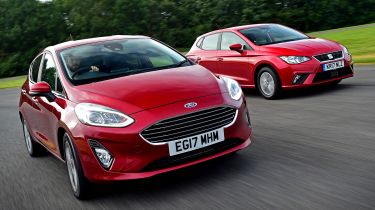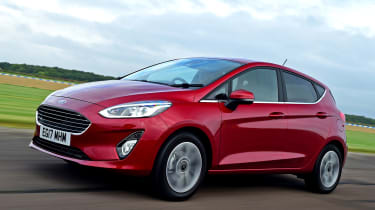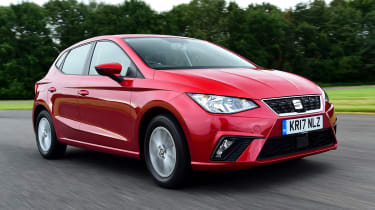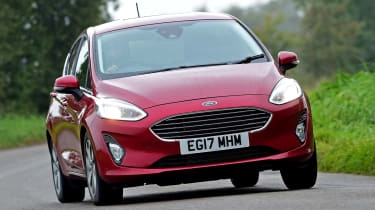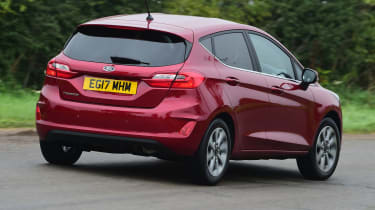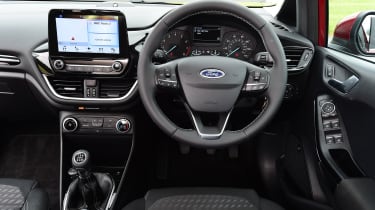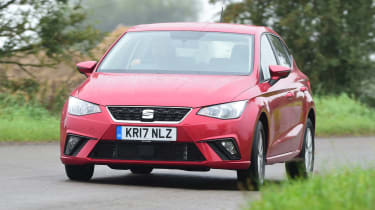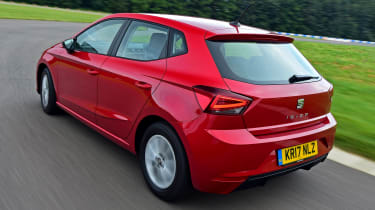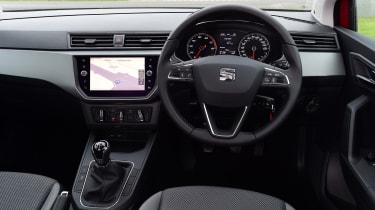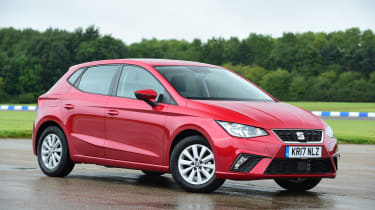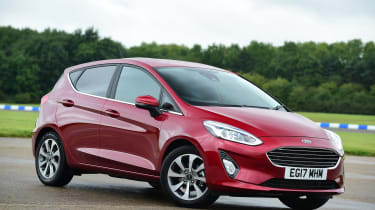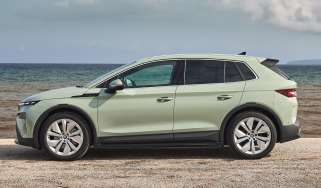Ford Fiesta vs SEAT Ibiza: a used budget supermini dance-off
Which is the better used supermini, an entry-level Ford Fiesta or a SEAT Ibiza?
When superminis arrived more than 50 years ago, they were basic and slow, with an emphasis on practicality. Over the years they’ve become faster and more luxurious, and because they’ve grown, they’re also more versatile than ever before.
But what if you don’t want a small car that’s packed with kit or able to outpace a nineties hot hatch? There were still plenty of options back in autumn 2018, when we pitted a SEAT Ibiza against a Ford Fiesta, with both of our test cars sitting towards the bottom of their respective ranges.
They each had non-turbo three-cylinder petrol engines, which meant they weren’t particularly fast, but they were relatively cheap to insure and also pretty frugal to fuel. Both models were launched in July 2017 and while the Fiesta has now been axed, the Ibiza is still on sale today.
There are hundreds of examples of each car available on the used market. They may not necessarily be in entry-level form as seen here, because posher editions were generally more popular, but that’s not to say they aren’t worth seeking out.
Ford Fiesta
- Prices from £6,000 (Ford Fiesta 1.0T Zetec 2017, 100k miles).
- For: Loads to choose from, wide model range, keen prices, lots of safety kit, really good fun to drive.
- Against: Refinement is disappointing, some materials are cheap, boot and rear-seat space are tight.
The Fiesta was killed off last year, having been launched in 1976, and ever since Auto Express arrived, we’ve loved Ford’s brilliant supermini. Even with the 1.1 engine, which is far from powerful, the Fiesta is fun to drive, courtesy of its good grip, sharp steering and supple suspension, which provides a smooth ride with excellent handling.
Ford’s supermini also has more low-down torque, so it feels perkier, but the car doesn’t come close to matching the Ibiza’s refinement. Inside, there’s plenty of space for passengers, a reasonable boot capacity and good-quality plastics, even if the Ibiza is significantly ahead in this respect. The same goes for kit levels, with SEAT more generous than Ford in this regard, although the Fiesta is far from spartan.
There are masses of used Fiestas for sale, but most have either turbocharged petrol or diesel engines. As a result, it’s easier to find a 99bhp model than one with 84bhp; the former starts at £6k for a Zetec that’s done 100,000 miles, while the latter costs the same for an 80,000-mile Zetec. Just £7,500 buys a 40,000-mile 1.1 Zetec, from 2018.
SEAT Ibiza
- Prices from £7,000 (SEAT Ibiza 1.0 TSI SE 2017, 85k miles).
- For: Impressive refinement and build quality, user-friendly dash layout, lots of cabin space and kit.
- Against: While the Ibiza is fine to drive, it doesn’t sparkle like the Fiesta. Its ride also isn’t as composed.
The Ibiza is a supermini that’s been around longer than Auto Express, albeit only just. It has blossomed into a superbly practical supermini that looks smart, is good to drive and has lots of kit as standard.
Beating the Fiesta dynamically is a big ask and while the SEAT’s gearchange is better, its steering is less communicative and the ride isn’t quite as well resolved; the slightly smaller engine can’t match the Fiesta’s spread of torque, either. But none of these are dealbreakers, because the differences aren’t stark. Where the Spanish supermini does lead is with interior space, boot capacity and ambience, while its refinement is also significantly better than the Ford’s, especially at higher speeds.
There aren’t as many Ibizas on the used market as there are Fiestas, but there’s plenty of choice. If you want one of the unusual 1.0 MPI editions as tested here, you’ll have to search, because most cars for sale are turbocharged TSI models. Expect to spend upwards of £7,000 to buy a fifth-generation Ibiza, which is enough to bag an 85,000-mile 1.0 TSI SE,
or a 70,000-mile 1.0 MPI, both on a 67-plate.
Which one should you choose?
First place: SEAT Ibiza
It takes quite a car to beat the Fiesta, but we reckon the Ibiza has what it takes, thanks to its more grown-up and roomier cabin, better refinement and extra standard equipment.
Second place: Ford Fiesta
Still a brilliant car that we wholeheartedly recommend, the Fiesta doesn’t quite have the edge over the Ibiza. But it’s the best dynamically, and there are more on sale.
Ford Fiesta vs SEAT Ibiza new car test: August 2018
Below is our original twin test of the Ford Fiesta and SEAT Ibiza as published in 2018. All information correct at time of publication...
We love the turbocharged 1.0-litre engines in the Ford Fiesta and SEAT Ibiza, two of the best superminis on sale. But for young drivers, or anyone who wants to make savings on insurance or the initial purchase price, there are lower-powered options.
In the Fiesta, a 1.1-litre three-cylinder does the job as the entry-level engine, while the Ibiza uses a 1.0-litre petrol. Both do without a turbocharger, but as with any supermini, they still have to offer enough performance blended with usability, style and a decent level of standard equipment.
That’s why we’ve brought these cars together, to find out which entry-level model makes sense for aspiring owners on a tighter budget.
Head-to-head
| Model: | Ford Fiesta 1.1 85PS Zetec 5dr | SEAT Ibiza 1.0 75PS SE Technology |
| Price: | £15,865 | £15,745 |
| Engine: | 1.1-litre 3cyl petrol | 1.0-litre 3cyl petrol |
| Power/torque: | 84bhp/108Nm | 74bhp/95Nm |
| Transmission: | Five-speed manual, front-wheel drive | Five-speed manual, front-wheel drive |
| 0-60mph/top speed: | 13.1 seconds/105mph | 15.2 seconds/104mph |
| Test economy: | 40.6mpg/8.9mpl | 39.9mpg/8.8mpl |
| CO2/tax: | 114g/km/£140 | 112g/km/£140 |
| Options: | Metallic paint (£495) | None |
Ford Fiesta
- For: Great driving experience, fun but composed chassis delivers good comfort
- Against: Interior looks a little plain, high-speed refinement not great
The Ford Fiesta is Britain’s best-selling car, and it’s easy to see why even with this lower-spec 1.1-litre model. It gets the formula just right: it’s fun to drive, fairly well equipped, economical and has plenty of space inside.
Those features aren’t changed by the engine under the bonnet, so this 1.1 non-turbo petrol, while underpowered next to Ford’s fantastic EcoBoost units, is still a decent choice.
Perhaps the Fiesta’s best feature is its chassis, because even in this low-spec trim level the car is great fun. There’s loads of grip, so while speed isn’t top of the agenda here, you can still enjoy driving through corners, thanks to the subtle feedback from the car. The Ibiza comes close; it’s also agile and its steering is direct, but it lacks the Ford’s sense of fun and adjustability.
While neither car performed strongly – these are the entry-level engines, after all – the Ford did beat the SEAT in most of our acceleration tests. It covered 0-60mph in 13.1 seconds, which was over two seconds up on the Ibiza’s 15.2-second time. Even a 5bhp hike won’t change that.
Perhaps more relevant to everyday driving is the 30-50mph time, and the Ford was faster here as well, in third and fourth gear. The Fiesta took 7.1 seconds in third and 11.7 seconds in fourth, comfortably ahead of the SEAT’s 7.9 and 13.2 seconds respectively. The new Ibiza won’t get any more torque, either, at 95Nm. Given the kerbweight stays the same, at 1,091kg, in-gear performance should be identical.
The Ford’s engine feels more responsive and eager here. However, the SEAT’s unit is smoother and at motorway speeds the Fiesta is noisier.
Alongside the handling, the Ford really comes into its own with the ride. Its suspension is great at absorbing bumps, which also adds up to strong refinement. This balance of dynamism and comfort is what sets the Fiesta apart in this class. It’s better to drive, but also more comfortable than the SEAT.
Interior quality is good, yet it’s here where the Ibiza makes up ground – it’s far more grown-up inside. There are more cheap-looking and feeling materials in the Ford, the design of the dash is plainer and the facia doesn’t have the more modern appearance of its Spanish rival.
Neither spec is particularly inspiring, and while you may be pleasantly surprised by the quality and kit you get for the price, it still trails the SEAT. Zetec trim brings air-conditioning, lane keep and a 6.5-inch touchscreen with smartphone tech.
Testers’ notes:
- Infotainment: SYNC3 infotainment system works well and the touchscreen is responsive enough. Graphics look a bit old fashioned, though
- Gearchanges: Five-speed box isn’t as sweet as six-speed set-up in other Fiestas, with less precise shifts
- Material quality: Latest Fiesta is better finished than before, but there are still some cheap plastics in places
SEAT Ibiza
- For: High-quality feel, sharp looks, fair level of kit
- Against: Poor performance, ride not as composed as Ford’s, not as engaging, either
Although it can’t match the Fiesta for sheer fun, the Ibiza is still a fine supermini that’s good to drive – and better than the Ford in some other key areas. It serves up direct steering, good grip and a great gearchange, so hustling down a twisty road is enjoyable; the SEAT just isn’t quite as lively as its rival.
The steering feels lighter and lacks the Ford’s level of reassuring communication, so you’re not as engaged with the driving experience as you are in the Fiesta.
On our test car’s standard 16-inch alloys, the SEAT rides nicely and bigger bumps are absorbed reasonably well, but the Ford is still more compliant, plus there’s a little more road noise in the Ibiza. The five-speed manual gearbox has a precise change that makes it easy and fun to use, and you will need to work it to get the most from the naturally-aspirated 1.0 litre.
You’ll almost always have to change down to accelerate, because there is a maximum of just 95Nm of torque, and with no turbo to bolster low-end performance, it’s developed relatively high up in the rev range, at 3,000rpm. It’s a similar story with the Ford, but because it offers 108Nm of torque it performed better in our tests.
This does affect the Ibiza’s flexibility, and from 30-70mph the car took 15.5 seconds. It feels slow when you’re heading on to a sliproad. The Ford completed the same test in 13.8 seconds, which means it’ll be a little easier to keep up with traffic, and it’s more urgent than the Ibiza around town as well.
A small power increase won’t change this. However, the SEAT’s engine is smoother than the Fiesta’s, and it has an entertaining thrum that makes going through the gears fairly fun. It’s almost as economical, too; we returned 39.9mpg on our mixed route.
One of the best things about the Ibiza is its interior space. Despite being a supermini, it has a really impressive 355-litre boot, which is almost as much as some family hatchbacks, and there’s plenty of leg and headroom in the back.
The interior design is more upmarket than the Ford’s as well, although some cost-saving hard plastics still feature. That’s easily forgiven in this class and at this price, because the SEAT still feels more modern than its rival. This is helped by the level of standard kit on offer, including the eight-inch infotainment system, Apple CarPlay, Android Auto, sat-nav, metallic paint, Bluetooth and air-con, plus the raft of safety tech included.
Testers’ notes:
- Infotainment: Upgraded infotainment spec sees Full Link included as standard, alongside built-in sat-nav
- Finish: Material quality is a bit better in the Ibiza than in the Fiesta, but there’s not much in it. The SEAT’s modern-looking design stands out more here
- Controls: Steering is light and direct, but it’s also numb and doesn’t inspire confidence like Ford’s
Verdict
First place: SEAT Ibiza
With these entry-level engines, the Ibiza pips the Fiesta thanks to its better tally of kit and greater versatility. It’s not as good to drive, nor as comfortable, but with little to split them on running costs, this budget-focused SEAT is the more appealing package.
Second place: Ford Fiesta
Despite its impressive breadth of ability, the Fiesta just falls short here. It’s great to drive and comfortable, too. The 1.1-litre engine is okay and offers decent efficiency, but ultimately it’s a small practicality deficiency and kit shortfall that see it just finish second.
